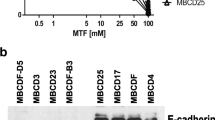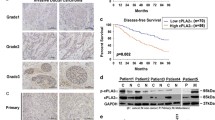Abstract
Recently we have shown that breast cancer cell invasion was dramatically increased when co-cultured with MG63 cells. In addition we have generated mesenchymal transformed MCF-7 breast cancer cells (MCF-7-EMT), showing significantly increased invasion in contrast to wild type MCF-7 cells (MCF-7 WT). In this study we have analyzed whether stromal derived factor-1 (SDF-1) is responsible for MCF-7 and T-47-D breast cancer cell invasion and epithelial–mesenchymal-transition (EMT). In addition we have analyzed whether kisspeptin-10 (KP-10) treatment affects SDF-1-induced invasion and EMT. Invasion was quantified by assessment of MCF-7 and T-47-D breast cancer cell migration rate through an artificial basement membrane in a modified Boyden chamber during co-culture with MG63 cells or after treatment with SDF-1α, SDF-1β or the combination of both isoforms. Induction of EMT was verified by analysis of protein expression of epithelial marker E-cadherin (CDH1) and mesenchymal markers N-cadherin (CDH2) and Vimentin (VIM). The role of SDF-1 for invasion and induction of EMT in breast cancer cells was analyzed by blocking SDF-1 secretion during co-culture with MG63 cells. In addition effects of KP-10 treatment on SDF-1-induced invasion and EMT were analyzed. Breast cancer cell invasion was significantly increased when co-cultured with MG63 cells. During co-culture SDF-1 protein expression of MG63 cells was significantly induced. The increased breast cancer cell invasion could be blocked by anti-SDF-1 antibodies. Treatment of breast cancer cells in monoculture (without MG63) with SDF-1α, SDF-1β or the combination of both isoforms resulted in a significant escalation of breast cancer cell invasion and induction of EMT. Protein expression of mesenchymal markers CDH2 and VIM was clearly elevated, whereas protein expression of epithelial marker CDH1 was clearly decreased. The SDF-1-induced increase of cell invasion was significantly reduced after treatment with KP-10. In addition, induction of EMT was inhibited. Furthermore, protein expression of the binding site of SDF-1, CXC-motive-chemokine receptor 4 (CXCR-4), was reduced by KP-10. Treatment of MCF-7-EMT cells with KP-10 resulted in a significant drop of cell invasion and CXCR-4 protein expression. Our findings suggest that SDF-1 plays a major role in breast cancer invasion and EMT. SDF-1-induced invasion and EMT can be inhibited by KP-10 treatment by down-regulating CXCR-4 expression.






Similar content being viewed by others

References
Christiansen JJ, Rajasekaran AK (2006) Reassessing epithelial to mesenchymal transition as a prerequisite for carcinoma invasion and metastasis. Cancer Res 66(17):8319–8326. doi:10.1158/0008-5472.CAN-06-0410
Kalluri R, Weinberg RA (2009) The basics of epithelial-mesenchymal transition. J Clin Invest 119(6):1420–1428. doi:10.1172/JCI39104
Muller A, Homey B, Soto H, Ge N, Catron D, Buchanan ME, McClanahan T, Murphy E, Yuan W, Wagner SN, Barrera JL, Mohar A, Verastegui E, Zlotnik A (2001) Involvement of chemokine receptors in breast cancer metastasis. Nature 410(6824):50–56. doi:10.1038/35065016
Balkwill F (2004) The significance of cancer cell expression of the chemokine receptor CXCR4. Semin Cancer Biol 14(3):171–179. doi:10.1016/j.semcancer.2003.10.003S1044579X03000981
Scotton CJ, Wilson JL, Scott K, Stamp G, Wilbanks GD, Fricker S, Bridger G, Balkwill FR (2002) Multiple actions of the chemokine CXCL12 on epithelial tumor cells in human ovarian cancer. Cancer Res 62(20):5930–5938
Wang J, Loberg R, Taichman RS (2006) The pivotal role of CXCL12 (SDF-1)/CXCR4 axis in bone metastasis. Cancer Metastasis Rev 25(4):573–587. doi:10.1007/s10555-006-9019-x
De La Luz Sierra M, Yang F, Narazaki M, Salvucci O, Davis D, Yarchoan R, Zhang HH, Fales H, Tosato G (2004) Differential processing of stromal-derived factor-1alpha and stromal-derived factor-1beta explains functional diversity. Blood 103(7):2452–2459. doi:10.1182/blood-2003-08-2857
Ziegler E, Olbrich T, Emons G, Gründker C (2013) Antiproliferative effects of kisspeptin10 depend on artificial GPR54 (KISS1R) expression levels. Oncol Rep 29(2):549–554. doi:10.3892/or.2012.2135
Lee JH, Miele ME, Hicks DJ, Phillips KK, Trent JM, Weissman BE, Welch DR (1996) KiSS-1, a novel human malignant melanoma metastasis-suppressor gene. J Natl Cancer Inst 88(23):1731–1737
Makri A, Pissimissis N, Lembessis P, Polychronakos C, Koutsilieris M (2008) The kisspeptin (KiSS-1)/GPR54 system in cancer biology. Cancer Treat Rev 34(8):682–692. doi:10.1016/j.ctrv.2008.05.007
Jiang T, Zhang SL, Lin B, Meng LR, Gao H (2005) Expression and clinical significance of KISS-1 and GPR54 mRNA in endometrial carcinoma. Chin J Oncol 27(4):229–231
Olbrich T, Ziegler E, Türk G, Schubert A, Emons G, Gründker C (2010) Kisspeptin-10 inhibits bone-directed migration of GPR54-positive breast cancer cells: evidence for a dose-window effect. Gynecol Oncol 119(3):571–578. doi:10.1016/j.ygyno.2010.08.018
Kang HS, Baba T, Mandai M, Matsumura N, Hamanishi J, Kharma B, Kondoh E, Yoshioka Y, Oishi S, Fujii N, Murphy SK, Konishi I (2011) GPR54 is a target for suppression of metastasis in endometrial cancer. Mol Cancer Ther 10(4):580–590. doi:10.1158/1535-7163.MCT-10-0763
Hori A, Honda S, Asada M, Ohtaki T, Oda K, Watanabe T, Shintani Y, Yamada T, Suenaga M, Kitada C, Onda H, Kurokawa T, Nishimura O, Fujino M (2001) Metastin suppresses the motility and growth of CHO cells transfected with its receptor. Biochem Biophys Res Commun 286(5):958–963. doi:10.1006/bbrc.2001.5470S0006-291X(01)95470-1
Takino T, Koshikawa N, Miyamori H, Tanaka M, Sasaki T, Okada Y, Seiki M, Sato H (2003) Cleavage of metastasis suppressor gene product KiSS-1 protein/metastin by matrix metalloproteinases. Oncogene 22(30):4617–4626. doi:10.1038/sj.onc.12065421206542
Navenot JM, Fujii N, Peiper SC (2009) Activation of Rho and Rho-associated kinase by GPR54 and KiSS1 metastasis suppressor gene product induces changes of cell morphology and contributes to apoptosis. Mol Pharmacol 75(6):1300–1306. doi:10.1124/mol.109.055095
Shoji S, Tang XY, Umemura S, Itoh J, Takekoshi S, Shima M, Usui Y, Nagata Y, Uchida T, Osamura RY, Terachi T (2009) Metastin inhibits migration and invasion of renal cell carcinoma with overexpression of metastin receptor. Eur Urol 55(2):441–449. doi:10.1016/j.eururo.2008.02.048
Roseweir AK, Katz AA, Millar RP (2012) Kisspeptin-10 inhibits cell migration in vitro via a receptor-GSK3 beta-FAK feedback loop in HTR8SVneo cells. Placenta 33(5):408–415. doi:10.1016/j.placenta.2012.02.001
von Alten J, Fister S, Schulz H, Viereck V, Frosch KH, Emons G, Gründker C (2006) GnRH analogs reduce invasiveness of human breast cancer cells. Breast Cancer Res Treat 100:13–21
Ziegler E, Hansen MT, Haase M, Emons G, Gründker C (2014) Generation of MCF-7 cells with aggressive metastatic potential in vitro and in vivo. Breast Cancer Res Treat 148(2):269–277. doi:10.1007/s10549-014-3159-4
Magliocco A, Egan C (2011) Breast cancer metastasis: advances trough the use of in vitro co-culture model systems. In: Gunduz E, Gunduz M (eds) Breast cancer—focusing tumor microenvironment, stem cells and metastasis. InTech open access publisher, Rijeka
Orimo A, Gupta PB, Sgroi DC, Arenzana-Seisdedos F, Delaunay T, Naeem R, Carey VJ, Richardson AL, Weinberg RA (2005) Stromal fibroblasts present in invasive human breast carcinomas promote tumor growth and angiogenesis through elevated SDF-1/CXCL12 secretion. Cell 121(3):335–348. doi:10.1016/j.cell.2005.02.034
Shirozu M, Nakano T, Inazawa J, Tashiro K, Tada H, Shinohara T, Honjo T (1995) Structure and chromosomal localization of the human stromal cell-derived factor 1 (SDF1) gene. Genomics 28(3):495–500. doi:10.1006/geno.1995.1180
Nagasawa T, Tachibana K, Kishimoto T (1998) A novel CXC chemokine PBSF/SDF-1 and its receptor CXCR4: their functions in development, hematopoiesis and HIV infection. Semin Immunol 10(3):179–185. doi:10.1006/smim.1998.0128
Yun HJ, Jo DY (2003) Production of stromal cell-derived factor-1 (SDF-1)and expression of CXCR4 in human bone marrow endothelial cells. J Korean Med Sci 18(5):679–685
Aust G, Steinert M, Kiessling S, Kamprad M, Simchen C (2001) Reduced expression of stromal-derived factor 1 in autonomous thyroid adenomas and its regulation in thyroid-derived cells. J Clin Endocrinol Metab 86(7):3368–3376
Ponomaryov T, Peled A, Petit I, Taichman RS, Habler L, Sandbank J, Arenzana-Seisdedos F, Magerus A, Caruz A, Fujii N, Nagler A, Lahav M, Szyper-Kravitz M, Zipori D, Lapidot T (2000) Induction of the chemokine stromal-derived factor-1 following DNA damage improves human stem cell function. J Clin Invest 106(11):1331–1339. doi:10.1172/JCI10329
Libura J, Drukala J, Majka M, Tomescu O, Navenot JM, Kucia M, Marquez L, Peiper SC, Barr FG, Janowska-Wieczorek A, Ratajczak MZ (2002) CXCR4-SDF-1 signaling is active in rhabdomyosarcoma cells and regulates locomotion, chemotaxis, and adhesion. Blood 100(7):2597–2606. doi:10.1182/blood-2002-01-0031
Koshiba T, Hosotani R, Miyamoto Y, Ida J, Tsuji S, Nakajima S, Kawaguchi M, Kobayashi H, Doi R, Hori T, Fujii N, Imamura M (2000) Expression of stromal cell-derived factor 1 and CXCR4 ligand receptor system in pancreatic cancer: a possible role for tumor progression. Clin Cancer Res 6(9):3530–3535
Navenot JM, Wang Z, Chopin M, Fujii N, Peiper SC (2005) Kisspeptin-10-induced signaling of GPR54 negatively regulates chemotactic responses mediated by CXCR4: a potential mechanism for the metastasis suppressor activity of kisspeptins. Cancer Res 65(22):10450–10456. doi:10.1158/0008-5472.CAN-05-1757
Castano JP, Martinez-Fuentes AJ, Gutierrez-Pascual E, Vaudry H, Tena-Sempere M, Malagon MM (2009) Intracellular signaling pathways activated by kisspeptins through GPR54: do multiple signals underlie function diversity? Peptides 30(1):10–15. doi:10.1016/j.peptides.2008.07.025
Schmidt E, Haase M, Ziegler E, Emons G, Gründker C (2014) Kisspeptin-10 inhibits stromal-derived factor 1-induced invasion of human endometrial cancer cells. Int J Gynecol cancer 24(2):210–217. doi:10.1097/IGC.0000000000000050
Lee BC, Lee TH, Avraham S, Avraham HK (2004) Involvement of the chemokine receptor CXCR4 and its ligand stromal cell-derived factor 1alpha in breast cancer cell migration through human brain microvascular endothelial cells. Mol Cancer Res 2(6):327–338
Acknowledgments
Grant support: Deutsche Krebshilfe—Dr. Mildred Scheel Stiftung. We thank Sonja Blume for excellent technical assistance.
Conflict of interest
The authors declare that they have no conflict interests.
Author information
Authors and Affiliations
Corresponding author
Rights and permissions
About this article
Cite this article
Gründker, C., Bauerschmitz, G., Knapp, J. et al. Inhibition of SDF-1/CXCR4-induced epithelial–mesenchymal transition by kisspeptin-10. Breast Cancer Res Treat 152, 41–50 (2015). https://doi.org/10.1007/s10549-015-3463-7
Received:
Accepted:
Published:
Issue Date:
DOI: https://doi.org/10.1007/s10549-015-3463-7



